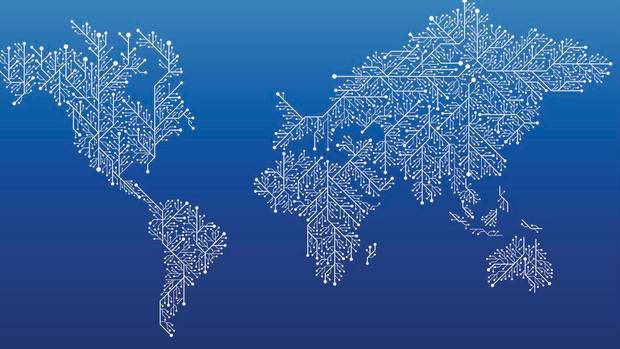Mobility vs Ubiquity: A Twisted Confusion (guest post by Max M. Mansoubi)

Max M. Mansoubi, Ph.D., S-Labs Founder
In the middle of the ongoing enthusiastic debate around the so-called Digital Assistants and conversational UX, it is not difficult to realize that two important words of the current technology lexicon are used or implied as if they were synonyms: Mobility and Ubiquity.
These words are not at all equivalent. Yet, apps design, investment decisions, strategic planning efforts, and end user device engineering are being made as if these words expressed the same concept. You may just ask: Is this only a question of exegesis and linguistic pedantry, or there is something a lot more critical that has to be revealed and discussed?
Mobility and Ubiquity Are Distinct Concepts
First things first. According to the American Heritage Dictionary, mobility means “the quality or state of being mobile,” while mobile is any entity “capable of moving or of being moved readily from place to place”, that is, throughout the physical environment. On the other hand, ubiquity is defined as “existence or apparent existence everywhere at the same time,” that is, “omnipresence.”

Based on these definitions, the relationship between mobility and ubiquity should be considered as similar to the way an automobile relates to the blue sky: A car moves among locations one at a time while the blue heaven is present everywhere. The fact of being able to see the sky (blue sky accessibility) through the car windows (means or channel of accessibility) doesn’t eliminate the distinction: An automobile is and remains a roving entity while the blue heaven is a constant property of the environment that is universally accessible by using the basic human physiological senses.
Notwithstanding the twisted lexical confusion, the reality once again exceeds the conventional wisdom. It is not actually difficult to distinguish two lines of technology development along two distinct emerging paradigms: Mobility as increasingly differentiated from ubiquity.
It is not actually difficult to distinguish two lines of technology development along two distinct emerging paradigms: Mobility as increasingly differentiated from Ubiquity.
Mobility and The “Smartphone”
Mobility paradigm allows for dampening as much as possible the disruptive constraints of time and physical spaces. This is about technologies designed to secure an objective context, an incubator-like condition for an attainable level of continuity across discontinuous experiences of the real world. Mobility paradigm is best expressed by what we still keep calling anachronistically ‘smartphone’. For the foreseeable future, the smartphone, in fact, is proving itself as a key player while ‘tablet’, which just a few years ago rose as the new shining star of the mobile computing, has already begun its decline following the desktop PC and Mac. The crossbreed called “phablet” is just a proof of the amazing cannibalizing power of the diehard smartphone.

The smartphone appears as the cyber-physical knight who has been cutting deep through our somnolent PC/Mac experience during the last decade or so. While laptops are becoming most probably the last sanctuary for the old PC and Mac universe, the smartphone is transforming at once itself and us by turning increasingly into the gateway of our personal Body Area Network (BAN): Wearable and implantable devices, and the upcoming replaceable smart human organs and body parts, as well as the futuristic nano-devices circulating in our bloodstream, will all route their bits and bytes through the smartphone.
The smartphone is here to stay while urging our technology lexicon to invent a new name to better reflect its metamorphosis.
Additionally, we have to expect a new wave of talking apps for the years to come. People increasingly conversing with their devices rather than placing a call through them will become a constant component of our busy urban life landscape. The noisy streets of Beijing and Shanghai offer a dazzling anticipation of talkative devices that are growing in the shadows while preparing to move to the limelight of the streets and alleys of San Francisco and beyond.
‘Hands-free’ and ‘eyes-free’ features are destined to become the baseline expectations for an increasing number of mobility-addict users, while the smartphone screen is dissolving by expanding to our smart glasses, contact lenses and the fantastic world of holograms. Voicebots, chatbots or more in general xbots are surfacing as the “spiritual creatures” who will populate our smartphones’ memory. This way, the smartphone will become the butler of the unfolding servicesphere: Without the smartphone, the thriving ‘O2O’ (Online-To-Offline) business model will never see a complete adulthood.
Ubiquity and “Sentient” Environments
Ubiquity paradigm is still in quest of its more genuine expression in the physical environment. That may partially explain the current lexicon confusion between mobility and ubiquity.

The unplanned and surprisingly rapid growth of Amazon Echo line of products, and the sequel of similar devices crafted by Google, Samsung, and a number of other brands are confirming the deep roots of flourishing demand among the consumers for sentient environments. No matter what the Apple CEO thinks, a smartphone is not the right answer to the users’ ubiquitous sentience requirements. Smartphone satisfies, in fact, the need for a personal butler, that is, a smart companion who remains always the same and shadows an individual everywhere to meet her service wishes. Smartphone is about us, our personal lifestyle while moving in the physical spaces.
Ubiquity relates to an ambient property that doesn’t follow a user but it is everywhere all the time as the baseline and embedded characteristic regardless of the (mobile) devices that a user might carry around.
Here a few examples from the household environment:
- A doormat that recognizes the homeowner
- Window blinds that spontaneously adjust the daylight by detecting a human presence
- A kitchen appliance enabled to identify and converse with its user
- The speaker volume that complies with a simple gesture command
- A bathroom mirror that can recognize a user and stream interactive and personalized news
- Toilet bowls and urinals enabled to warn for potential health conditions, etc.
The current success of products such as Amazon Echo or Google Home seems to arise essentially from their almost “Shamanic” property to act as a new access layer (very similar to what in computing is called “abstraction layer”) between the user and the surrounding environment complexity. That’s why it would be wrong to consider them a replacement for the smartphone. As mentioned above, the latter facilitates the mobility across different locations and timeframes while these new products are destined to make friendlier and more intuitive the physical locations such as homes, offices and gradually entire cities.
From Ubiquitous Access Layer to Ambient Intelligence
However, we have to keep in mind that the ‘access layer’ property will inevitably evolve over time and could gradually get reabsorbed by the built environment components. In other words, the ’embodied technologies’ (separate devices or gadgets) will increasingly transform into ’embedded intelligence’ by disappearing into our surroundings until only the (virtual and/or fluid) user interface remains perceivable. From this point of view, all the current AI-based voice devices (Echo, Google Home, and other similar pieces of hardware) should be considered simply as transient stages of a higher level development that will eventually make them superfluous–at least in their current format.
We still have to look forward to seeing the ubiquity paradigm finally usher in full-blown Ambient Intelligence. Very recently a friend reminded me an almost forgotten meme: “Facebook is the only place where it is acceptable to talk to a wall.” Well, with the Ambient Intelligence that won’t be true anymore.
This guest post is from Max M. Mansoubi, founder and executive director R&D at S-Labs. It is the first of a series of copyrighted articles that originally appeared on LinkedIn.








